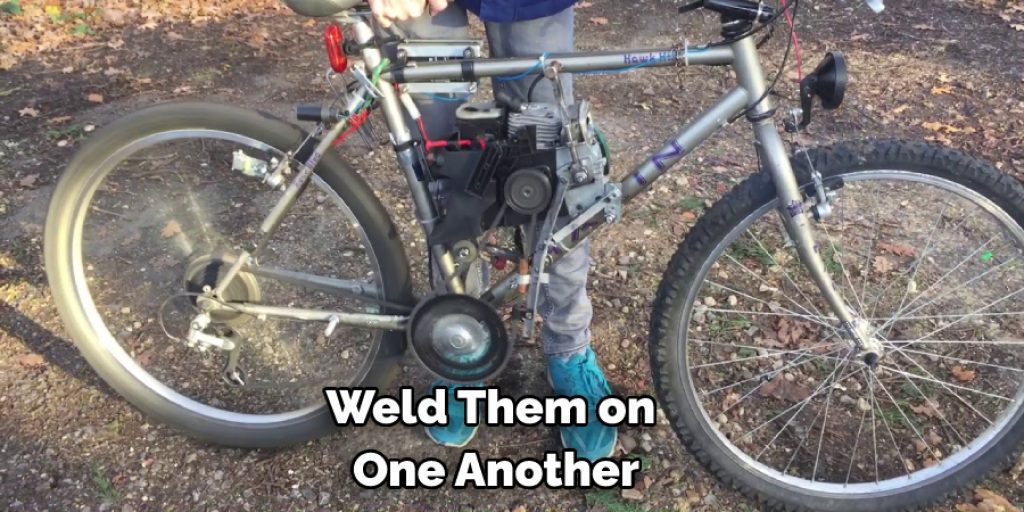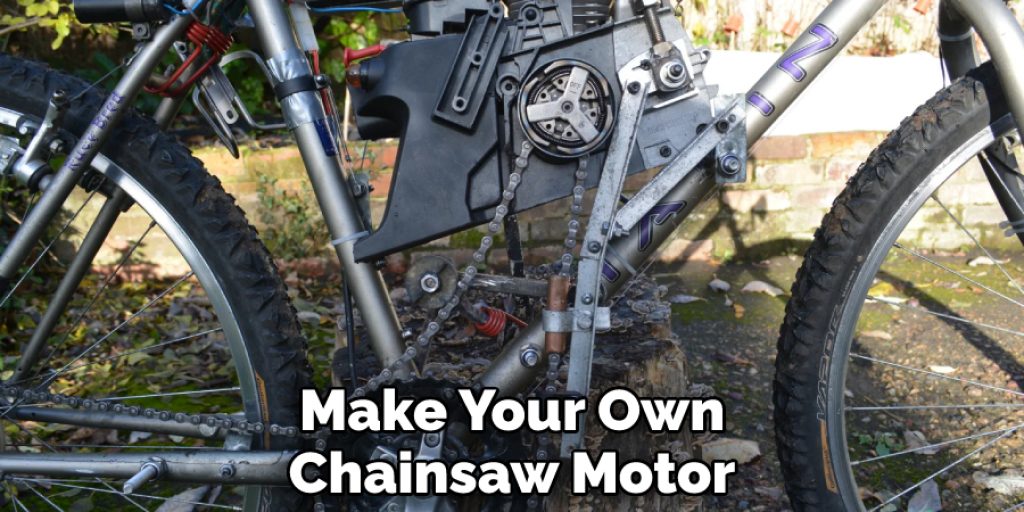How to Put a Chainsaw Motor on a Bicycle
Introduction
Chainsaw bike! Sounds spooky, right? But have imagined how much functionality you will be able to obtain with this bike. But to acquire that, you have first to learn how to put a chainsaw motor on a bicycle. Do you know how you can do that? Well, don’t worry; I have crafted this article so that even a layperson will be able to make his own chainsaw bike. So, let’s see how to do that.

Chainsaw bike! Sounds spooky, right? But have imagined how much functionality you will be able to obtain with this bike. But to acquire that, you have first to learn this. Do you know how you can do that? Well, don’t worry; I have crafted this article so that even a layperson will be able to make his own chainsaw bike. So, let’s see how to do that.
How To Put A Chainsaw Motor On A Bicycle
First of all, you have to remove the chainsaw’s cover and adjust the 10 MM V belt pulley with the chainsaw. Then, take an engine mounting bracket; you can use the simplest one made out of scrap metals for this process. Next, mount the chainsaw with this bracket through its existing holes. Of course, this means you are gonna have to make the holes according to that position.
After that, take a 26:1 worm gear reducer and adjust a 16-tooth sprocket with it. You may need to replace the center nut with a large one for that. Next, take a 10×350 V-belt and equip it with worm gear and the chainsaw machine. Finally, secure it on the mounting bracket properly.
Next, take a one-way bike sprocket and a 24-tooth sprocket. Weld them on one another. Remove the old wheel from your bicycle and equip this sprocket with it. Now, set the wheel again and adjust the chainsaw machine on your cycle’s rear part of the carrier. Adjust the chains along with the sprockets, and that’s it; your chainsaw bike is ready to go now. You can now ride in your own will and go as far as you want to go.
Precautions:
– Wear safety goggles to protect your eyes from dirt and debris.

– Make sure the chainsaw engine is off before you start working on it to avoid injury.
– Use a piece of wood as a buffer between the handlebars of your bicycle and the spinning saw blade while attaching them with screws. This will prevent friction burns or injuries if they touch during operation.
– For those who want their bike without brakes, use an old brake cable instead of the metal wire that connects both handles when pedaling backward for braking purposes.
The Benefit of Chainsaw Motor on A Bicycle:
The benefit of putting a chainsaw motor on a bicycle is that the bike can go up and down hills without you having to pedal. The only thing you will have to do is turn your body in the direction that needs power, but it allows for easier pedaling when going downhill because there’s gravity aiding it.
It also means that if your feet get tired or hurt before you finish riding, which often happens with long or steep rides, then they don’t matter anymore! You’ll still be able to use them just as much as anyone else who doesn’t need their legs for balance.
Disadvantages of Chainsaw Motor on A Bicycle:
The disadvantages of putting chainsaw motors on bicycles are that it is hard and time-consuming. You have to be very careful when drilling the hole for the motor since you can damage your bike and injure yourself if done wrong. It will take many hours either with electric tools or by hand, so make sure to put in enough effort before beginning this project. Otherwise, it won’t work out too well. There are other ways you could go about using a bicycle as transportation instead of pedal-powered bikes, which don’t require any fuel at all.

However, the major drawback of the chainsaw bike is that it is not environmentally friendly. The fuel-powered engine emits harmful gases just like any other motor vehicle, contributing to air pollution. So, if you are considering putting a chainsaw motor on your bicycle, make sure to weigh the pros and cons before proceeding.
11 Step-by-step Guidelines on How to Put a Chainsaw Motor on a Bicycle:
Step 1: Gather Your Tools & Materials
Before you begin, make sure you have all the necessary tools and materials. You will need:
A Chainsaw Motor:
Make sure it is functioning correctly and not damaged.
A Bicycle:
Choose a bicycle that is in good condition. It should be able to handle the weight of the chainsaw motor.
V-Belt Pulley:
This will help you connect the sprocket to the chainsaw motor.
Engine Mounting Bracket:
You can use an old bracket or make one yourself from scrap metal.

Worm Gear Reducer:
This will help reduce the high speed of the chainsaw motor.
16-tooth Sprocket:
You can use a bicycle sprocket or buy one separately.
10×350 V-Belt:
Choose a strong and durable belt that is compatible with the worm gear and chainsaw motor.
One-Way Bike Sprocket:
This will help you to pedal backward as well for braking purposes.
24-tooth Sprocket:
Weld this sprocket onto the one-way bike sprocket.
Step 2: Remove the Chainsaw Cover

For easier access, remove the cover of your chainsaw. This will help you determine the correct positioning of the V-belt pulley. But make sure the chainsaw engine is off before you do this. The motor’s cover will be put back on after you have attached the chainsaw to the bicycle. It is essential to have the chainsaw in good working condition before starting this project. You don’t want to have any unexpected breakdowns while riding.
Step 3: Attach the V-Belt Pulley
Take your 10 MM V-belt pulley and attach it to the chainsaw. Make sure it is tightly secured; a loose pulley will not work either. You can also use a metal screw or bolt to secure the pulley in place. It is important to align the pulley with the chainsaw’s drive shaft. You can use a ruler or measuring tape to ensure proper alignment. But make sure the pulley does not obstruct any of the chainsaw’s moving parts. The V-belt pulley is what will connect the chainsaw to the bicycle’s sprocket. You can also use a pulley of a different size, depending on your preference.
Step 4: Create a Mounting Bracket
Next, create a mounting bracket for your chainsaw motor. You can use scrap metal and bend it into a shape that will fit snugly onto your bicycle. This will help to keep the motor in place while the bicycle is in motion. I recommend using a 2-inch angle bracket for this purpose. You may also need to drill holes in the bracket according to the placement of your chainsaw’s attachment points. It is essential to make sure the bracket is sturdy and can hold the weight of the motor. The bracket will be attached to the bicycle’s frame.
Step 5: Create Holes for the Mounting Bracket
You may need to drill holes into your bicycle’s frame to attach the mounting bracket. Make sure you mark and measure the position of the holes before drilling them. This will help ensure that everything lines up correctly. There should be two holes on the rear part of your bicycle’s frame and two smaller holes on the bottom bracket. You can also use a 5/16-inch bolt and nut to attach the mounting bracket. But make sure it is securely fastened to avoid any accidents while riding. It is essential to have a stable and sturdy base for the chainsaw motor.
Step 6: Attach the Mounting Bracket to the Bicycle
Once you have drilled the holes, attach the bracket to your bicycle’s frame using screws or bolts. Make sure the bracket is tightly secured and will not move while riding. Otherwise, it could cause damage to your bicycle or result in injury. It is also essential to ensure that the bracket is placed in a way that will not interfere with your pedaling motion. However, keep in mind that it should be close enough to the chain sprockets for easy connection to the chainsaw motor.

Step 7: Attach the Chainsaw Motor
Now it’s time to attach the chain saw motor to the bicycle. Place the chainsaw on its side so that it is parallel to the bicycle’s frame. Then use bolts or screws to connect the chainsaw’s mounting holes to the bracket attached to your bike. It is important to securely fasten the chainsaw onto the bicycle as this will be providing the main source of power. The motor should be placed on the same side as the rear wheel of your bicycle.
Step 8: Connect the Motor to the Sprocket
After you have attached the chainsaw motor, it’s time to connect it to the sprocket. Take your worm gear reducer and attach it to the chainsaw motor. Then, take your 16-tooth sprocket and place it onto the worm gear. Once secured, attach the V-belt to the motor’s pulley and connect the other end of the belt to the 16-tooth sprocket. This will transfer power from the chainsaw motor to the bicycle. It is important to make sure that the belt is tight and properly aligned for optimal performance.
Step 9: Connect One-Way Sprocket

Next, weld your one-way bike sprocket and 24-tooth sprocket together. This will allow you to pedal backward as well for braking purposes. Make sure to weld it securely, so it doesn’t come apart while riding. Otherwise, it could cause accidents. It is essential to have a functioning one-way sprocket for safety while riding. You can also install a handbrake if you prefer, but the one-way sprocket is essential for this setup to work correctly.
Step 10: Connect One-Way Sprocket to Rear Wheel
Attach the welded one-way sprocket and 24-tooth sprocket onto your rear wheel. Make sure it is placed on the same side as the chainsaw motor you attached. The sprockets should be aligned with each other for proper functionality. Once everything is securely in place, you are ready to take your homemade bike with a chainsaw motor for a test ride! But remember to always prioritize safety and wear protective gear while riding. Have fun with your new motorized bicycle!
Step 11: Tweak and Adjust
As with any DIY project, there may be some tweaks and adjustments needed to get the best performance out of your motorized bicycle. You may need to adjust the alignment of the sprockets or tighten/loosen the belt for optimal power transfer. It is also important to regularly check and maintain the chainsaw motor and other components to ensure safe and efficient riding. Experiment with different gear ratios for varying speeds and have fun customizing your motorized bicycle according to your preferences.
Following these steps on how to put a chainsaw motor on a bicycle, you can easily transform your regular bicycle into a motorized one using a chainsaw motor. Not only is it a fun and unique project, but it also allows for an eco-friendly mode of transportation. So get creative and start pedaling (and sawing) away! Happy riding! #End of Document
Do I Have Any Recommendations for Which Brand Makes the Best Chainsaw Motors for Bicycles?
You could probably make your own chainsaw motor with a couple of electric motors and gearboxes, but there are pre-made options as well. So the best advice I can give you is to find out what the top-rated bike for sale in your area is and then look at their manufacturer’s website or website that sells it (like this one).
Many bikes have parts available online, so they may be able to help as well. Plus, if you buy something from an established company like Trek Bikes, which has been making bicycles since 1976, then you know that whatever part you need will fit perfectly!
It may also be helpful to read reviews and get recommendations from other DIY enthusiasts or bike shops that specialize in custom motorized bicycles. Ultimately, it will depend on your budget, the type of bicycle you have, and personal preference. So do some research and choose a reputable brand with good quality products for the best results.
Frequently Asked Questions:
Q: Is It Safe to Ride a Bicycle With a Chainsaw Motor?
A: As with any motorized vehicle, it is important to prioritize safety while riding. Always wear protective gear such as a helmet and follow proper traffic laws. It is also crucial to regularly check and maintain the chainsaw motor and other components for safe operation.
Q: How Fast Can a Bicycle With a Chainsaw Motor Go?
A: The speed of your motorized bicycle will depend on various factors such as the power output of your chainsaw motor, the gear ratio, and terrain. It is important to find the right balance for optimal performance and safety. You can experiment with gear ratios to achieve your desired speed.
Q: How Do I Maintain My Motorized Bicycle?
A: Regular maintenance is key to the safe and efficient operation of your motorized bicycle. This includes checking the chainsaw motor, gears, sprockets, and belt for any wear or damage. Keep them clean and lubricated as necessary. It is also important to regularly check the tire pressure, brakes, and other components for safe riding. Additionally, make sure to follow any manufacturer’s guidelines or instructions for maintenance specific to your chainsaw motor.
Q: Can I Use a chainsaw Motor for My Bicycle?
A: It is recommended to use a chainsaw motor with a power output of 25-50cc for a bicycle. However, it is important to ensure that the motor is compatible and can be safely mounted onto your bike frame. Additionally, make sure to follow any local laws or regulations regarding the use of motorized bicycles on public roads.
Q: Can I Use an Electric Chainsaw Motor?
A: It is possible to use an electric chainsaw motor for a bicycle, but it may require additional equipment such as a battery and controller. It is important to ensure that the motor has enough power and torque for your specific bike setup.

Overall, using an electric chainsaw motor may be more complex and expensive compared to a gas-powered one. It is recommended to do thorough research and consult with experienced individuals before attempting to use an electric chainsaw motor for a bicycle.
Conclusion:
Lastly, the process we have stated here will help put a chainsaw motor on a bicycle. This will surely help increase the performance of your commuter. And we hope that this article has helped you in understanding how to put a chainsaw motor on a bicycle and all the necessary parts required for it. Always remember to prioritize safety while riding and have fun with your new motorized bicycle! We wish you happy riding!
You may also read now – How to Braid Leather Around a Handle




